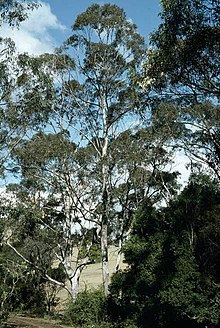Eucalyptus quadrangulata
| White-topped box | |
|---|---|

| |
| Eucalyptus quadrangulata | |
| Scientific classification | |
| Kingdom: | Plantae |
| Clade: | Tracheophytes |
| Clade: | Angiosperms |
| Clade: | Eudicots |
| Clade: | Rosids |
| Order: | Myrtales |
| Family: | Myrtaceae |
| Genus: | Eucalyptus |
| Species: | E. quadrangulata
|
| Binomial name | |
| Eucalyptus quadrangulata | |

Eucalyptus quadrangulata, commonly known as the white-topped box or coast white box,[2] is a species of small to medium-sized tree that is endemic to eastern Australia. It has rough, fibrous or flaky bark on the trunk and branches, lance-shaped to curved adult leaves, flower buds in groups of seven, white flowers and conical fruit.
Description
Eucalyptus quadrangulata is a tree that typically grows to a height of 45–50 m (148–164 ft) and forms a
Taxonomy
Eucalyptus quadrangulata was first formally described in 1899 by
Distribution and habitat
White-topped box grows in the slopes and edges on the eastern side of the Northern and Central Tablelands in New South Wales, between Dorrigo and Scone in the north to Bundanoon and Milton in the south. There is also a disjunct population near Cunninghams Gap in south-eastern Queensland.[2][4][8]
References
- ^ "Eucalyptus quadrangulata". Australian Plant Census. Retrieved 7 December 2019.
- ^ a b c Hill, Ken. "Eucalyptus quadrangulata". Royal Botanic Garden Sydney. Retrieved 8 December 2019.
- ^ "Eucalyptus quadrangulata". Euclid: Centre for Australian National Biodiversity Research. Retrieved 30 May 2020.
- ^ a b Chippendale, George M. "Eucalyptus quadrangulata". Australian Biological Resources Study, Department of the Environment and Energy, Canberra. Retrieved 8 December 2019.
- ISBN 0909605629.
- ^ "Eucalyptus quadrangulata". APNI. Retrieved 8 December 2019.
- ^ Deane, Henry; Maiden, Joseph (1899). "Observations on the eucalypts of New South Wales, Part V". Proceedings of the Linnean Society of New South Wales. 24 (3): 451–454. Retrieved 8 December 2019.
- ISBN 0-9594711-2-Xpage 121
